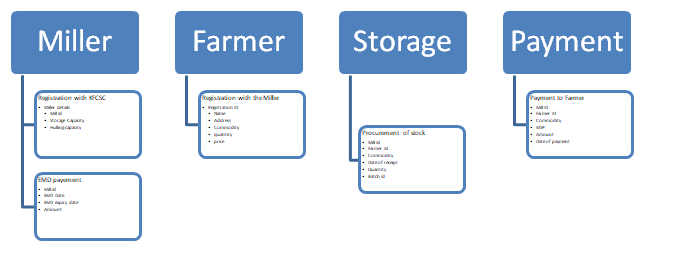
Introduction
Subsidised ration distribution takes place each month to the ration card holders across the state under public distribution system (PDS). PDS involves procurement from the farmers till distribution to ration card beneficiaries comprising different entities in between such as central and state agencies, millers, transporters, shop owners and then finally to the beneficiaries.
A major feature of the PDS is the general lack of accountability down the entire supply chain, leaving the leakages that occur at different points completely unaccounted. BlockChain technology can be useful in managing supply chain effectively using distributed ledger technology. Entire supply chain starting from procurement till disbursement can be part of blockchain.
Process Flow
Farmer cultivates the foodgrains which is then procured by the government under minimum support price (MSP). Millers identified by the government collects foodgrains initially and then hull it (depending on the commodity) to be returned to government.
It is then moved to state godowns to be distributed to various block godowns. From the block godowns these commodities gets distributed to various fair price shops (FPS) for beneficiary distribution.
Government agencies identify and allow the millers to register with them for the purpose. Farmers register with the millers to deposit their produce and collect their payment under MSP.
A farmer gets paid under MSP based on the quantity supplied. Miller then processes these commodities to make it available at storage points for further distribution. Miller gets paid for processing these commodities. Miller also gets paid for transporting them to nearest state godowns. Fair price shop owner collects his quota from these storage points to be distributed to the beneficiaries.
Role of BlockChain
Use of blockchain can remove at least delay in payment to the farmers based on procurement done by the miller. Since miller is responsible for the collection and stock initially unless the transaction is approved by the farmer, miller cannot register the quantity collected. This makes each transaction Non-repudiation.
Since calculation and payment must happen based on this initial data, data provenance (recording history of data) can be sealed using blockchain technology. The decentralized distributed ledger makes all the stake holders refer to their local copy of the ledger to make decisions and act accordingly.
Certain activities such as payment to farmers can be done without waiting for the miller to hull them. Since the procurement season is defined for each commodity, payment can start immediately without waiting for the other actors to complete their process.
This makes each transaction as non-time critical and thus eligible to be part of blockchain technology. Since farmer only interacts with the government identified millers it needs not be part of a public chain where in transporter is participating in the network.

Current status of POC
The POC application for PDS is developed as a python web application with three stakeholders namely miller, farmer and the Admin user. The application interacts with the blockchain node and to the RDBMS and is deployed in Docker container. The POC covers the procurement process of PDS which involve the miller registration with the government and the farmer registration with the miller. The registration modules writes the registration details to the blockchain as well as to the database. The data updating modules read the existing data from the block chain and write back the updated details. The super user module provides option to read and compare the data from both the database and the blockchain which in turn helps to identify any data update anomalies.